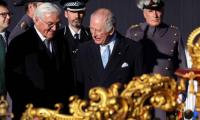In one of his articles, Dr Mubarak Ali mentioned in passing that Mr Jinnah used to claim that he had founded Pakistan with the help of his typewriter and stenographer. Dr Safdar Mahmood, a former bureaucrat, didn’t like it and questioned this version of history.
When Dr Mubarak Ali responded with evidence, no newspaper was ready to publish his response apart from one Urdu newspaper. Dr Ali appears to be fond of such provocations, and he also mentioned with evidence that Jinnah was not happy with Muslim League leaders, a majority of whom he considered incompetent and unable to take the reins of the country. In another article Dr Mubarak Ali writes:
“As is the norm in our country, some people profusely flattered Quaid-e-Azam in his lifetime. When the Constituent Assembly elected him president of the House, Liaquat Ali Khan declared that it was an honour for the Assembly to have Quaid-e-Azam as its president because he was the builder of Pakistan who had honestly and selflessly acquired the country. Some people even started calling him emperor of Pakistan and in Karachi a Khutba (sermon) was delivered in his name and he was called the leader of the pious”. (Reference from Khalid Bin Saeed’s book, ‘The formative phase 1857 – 1948’).
Another achievement of Dr Mubarak Ali is that he has introduced new topics of history in Urdu. One of his books is ‘Niji Zindagi ki Tareekh’ (History of private life) in which he introduced some French historians belonging to the Annales School which did research on the history of the private lives of people and published it in five volumes. Beginning from the Roman and Byzantine eras, the fifth volume concludes with the present age. A distinguishing feature of the book is that it projects various aspects of private lives with the help of illustrations, paintings, and sculptures.
As mentioned earlier, Dr Mubarak Ali’s work also includes translations. Two important books that he rendered from German into Urdu are by Bertolt Brecht’s (1898 – 1956) ‘Mulhid ka Overcoat’ (The Heretic's Coat) and Heinrich Boll’s (1917 – 1985) ‘Katharina Blum ki Khoi hui Izzat (The lost honour of Katharina Blum). ‘Mulhid ka Overcoat’ not only contains an introduction to Brecht but also his other essays and stories. In the introduction Dr Mubarak Ali writes these line that apply to present-day Pakistan as well:
“Brecht had in front of him the persona of Hitler who had used his demagoguery and personality cult to enthrall the minds of the entire German nation which was immersed in emotionalism and followed him blindly. A personality cult destroys all opposition and freedom of expression. In those circumstances Brecht encouraged intellectuals to break free from state oppression. When there are restrictions, we should find new ways to oppose them.” (Page 7, published in 1996).
This is just a 100-page book but it contains some gems from Brecht including this 10-page story about Giordano Bruno (1548 – 1600). Brecht narrates how the church inquisition targeted Bruno in a false case but Bruno stood fast. He said: “You are delivering this verdict under duress and fear.” The story is about an incident in which a rich man of Venice hires Bruno to give him lessons in physics, but wants him also to teach sorcery and black magic. Unable to learn any such skills from Bruno, and to withhold his fees, the rich man accuses Bruno of blasphemy against Christianity.
Bruno was arrested in 1592 and after eight years of imprisonment and prolonged inquisition case, was burned at the stake in 1600. When in 1592 Bruno lived in a rented house, he commissioned a tailor to stitch an overcoat for him, but he was arrested before he could make payment. He was unable to pay the tailor who demanded payment while Bruno was in jail. During the case hearings, Bruno repeatedly requested the court to allow him to make payment to the tailor but the court rejected his pleas.
This translation by Dr Mubarak Ali is worth reading: “Till his last days Bruno fought for his right to make the payment; he was less interested in saving his skin which he knew he would not be able to do, so he was more concerned about the tailor and argued again and again with the authorities about the payment of the overcoat.”
Another good book of Dr Mubarak Ali is ‘Europe ka Urooj’ (The rise of Europe) in which he narrates how Europe reached the pinnacle of civilization by getting European societies out of the Church’s domination through the Renaissance and enlightenment, and what were the ramifications of the industrial and French revolutions.
Dr Mubarak Ali has also touched upon some unusual subjects in history, and one such book is ‘Tareekh aur Aurat’ (History and Women). In Urdu we hardly get to read about this topic. Before Dr Mubarak Ali we had books such as Ashraf Ali Thanvi’s ‘Baheshti Zever’ translated into English as ‘Heavenly Ornaments’ by Masroor Khan Saroha; and Maulana Maudoodi’s ‘Purdah’ (Veil). These and other similar books focused on how women could be kept subservient to men and how women should cover themselves up in accordance with norms and traditions.
Perhaps, Dr Mubarak Ali is the first Pakistani historian who has written a concise book on this topic and which should be compulsory reading for all girls and women. As an educationist, I would even recommend that it be used as a textbook in our colleges and schools not only for girls but also for boys and men so that they understand the historical background of women’s status in society. On page seven he writes:
“In the history dominated by men, women emerge in a form and shape that has no dignity and respect. Rather, an impression emerges in which sometimes we hate women and at others we tend to feel pity on them. Yet in most cases she is totally ignored and her sacrifices are never mentioned that men extract from her to serve men’s own interests.”
He rejects some intellectual’s argument that in classless societies women had an equal status with men. He writes: “In classless societies too, women’s status was not equal to men, as the examples of Australian tribes and Eskimos show. It is correct that unequal hierarchy emerged after private property came about in which they needed heirs. But even in tribal societies men considered women as their properties and used them for their own benefits.”
His book ‘Tareekh aur Aurat’ (History and women) is replete with references from Islamic and world histories: “When Babur was in Samarqand his enemy Shaibani Khan besieged the city and there was no hope for Babur to flee or succeed. He bought his escape by handing over his sister Khanzada Begum in marriage to Shaibani Khan.”
Later he continues: “We also see a mention of women in history when the booty was collected after a battle. One of the most important parts of the booty was women who were distributed among the victors just as diamonds, pearls, cloths, and carpets were given away. Even if a woman had some social status that immediately vanished after she became a prisoner of war. She was relegated to the status of a female slave and her master had every right to use her at his pleasure, be it sexual relations or giving her away to somebody else.” (Page 9)
Other chapters include topics such as women in Indian civilization, the church and women, women and prostitutes, and industrial society and women. The list of works by Dr Mubarak Ali is long, including ‘Tareekh aur Firqa Wariyat’ (History and sectarianism), ‘Tareekh aur Khane ke Aadab’ (History and eating etiquettes), ‘Bazaar aur Doosre Mazameen’ (Bazaar and other essays). He remains the foremost historian writing in Urdu today. May he live long and keep guiding us.
Concluded
The writer holds a PhD from the University of Birmingham, UK and works in Islamabad.
Email: mnazir1964@yahoo.co.uk















